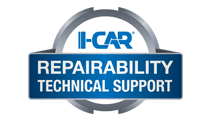
OEM Restraints System Part Replacement Search
2013 Ford Escape
DISABLE PROCEDURE AND TIME (Always Check Service Manual)
WARNING: Always deplete the backup power supply before repairing or installing any new front or side air bag supplemental restraint system (SRS) componentand before servicing, removing, installing, adjusting or striking components near the front or side impact sensors or the restraints control module (RCM). Nearby
components include doors, instrument panel, console, door latches, strikers, seats and hood latches.
To deplete the backup power supply energy, disconnect the battery ground cable and wait at least 1 minute. Be
sure to disconnect auxiliary batteries and power supplies (if equipped).
1. Turn all vehicle accessories OFF.
2. Turn the ignition OFF.
3. At the BCM , remove RCM fuse 86 (10A). Refer to the Wiring Diagrams Manual Cell 11.
4. Turn the ignition ON and monitor the air bag warning indicator for at least 30 seconds. When the correct fuse has been removed, the air bag warning indicator remains lit
continuously (not flashing). If the air bag warning indicator is not lit continuously, remove the correct RCM fuse before proceeding.
5. Turn the ignition OFF.
6. Remove the battery cable body ground terminal stud and disconnect the battery ground cable at the LF strut tower. Make sure the ground cable is completely isolated from the
vehicle chassis and cannot make electrical contact with any part of the vehicle chassis during service.
7. Wait at least one minute before continuing vehicle service.
REV: 10/2012
PARTS THAT MUST BE REPLACED FOLLOWING A DEPLOYMENT
When any deployable device or combination of devices have deployed and/or the RCM has DTC B1231/B1193:00 (Event Threshold Exceeded) in memory, the repair of the vehicle SRS is to include the removal of all deployed devices and the installation of new deployable devices, the removal and installation of new impact sensors and the removal and installation of a new RCM.Removal of all deployed devices and the installation of new deployable devices: [AIRBAG,STEERING WHEEL; AIRBAG,INSTRUMENT PNL; AIRBAG,FRONT SEAT; AIRBAG,ROOF]
Removal and installation of new impact sensors and the removal and installation of a new RCM: [AIRBAG SENSOR,FRONT; AIRBAG SENSOR,FRT DOOR; AIRBAG SENSOR,QTR PANEL; MODULE,AIRBAG CONTROL]
When the driver air bag module has deployed, a new clockspring must be installed.
If a side air bag deployment took place, a new seat back pad, trim cover, side air bag module and nuts must be installed. The seat back frame should be replaced if necessary
New driver safety belt systems (including retractors, buckles, anchors and height adjusters) must be installed if the vehicle is involved in a collision that results in deployment of the driver safety belt pretensioners.
New front passenger safety belt systems (including retractors, buckles, anchors and height adjusters) must be installed if the vehicle is involved in a collision that results in deployment of the front passenger safety belt pretensioners.
Install new safety belt(s) at any seating position(s) where safety belt deployment has occurred and the safety belt(s) were used
PARTS THAT MUST BE INSPECTED AND REPLACED IF DAMAGED
When a vehicle has been involved in a collision and the OCSM has DTC B1231/B1193:00 stored in memory, the repair of the OCS is to include the following procedures for thespecified system: For bladder-type OCS system, inspect for damage and repair as necessary. If installation of an OCS system component is required, an OCS system service kit must be installed.
When any damage to the impact sensor mounting points or mounting hardware has occurred, repair or install new mounting points and mounting hardware as needed.
Inspect the entire vehicle for damage, including the following components:
• Steering column (deployable column if equipped)
• Instrument panel knee bolsters and mounting points
• Instrument panel braces and brackets
• Instrument panel and mounting points
• Seats and seat mounting points
• Safety belts, safety belt buckles, safety belt retractors and safety belt anchors.
• SRS wiring, wiring harnesses and connectors
After a crash, the following safety belt components and attaching hardware must be inspected and tested to verify correct function at all seating positions:
• Retractors
• Buckles
• Safety belt shoulder belt height adjusters (if equipped)
• Front safety belt buckle support assemblies (slide bar) (if equipped)
• Automatic Locking Retractor (ALR) feature for child safety seats (passenger seating positions only)
• Child safety seat tether bracket assemblies
• Lower anchors and tethers for children
• Belt Tension Sensor (BTS) (if equipped)
• Inflatable safety belt systems (if equipped)
Before installing a new safety belt assembly, inspect all safety belt attaching points for damage and distortion. If the attaching points are damaged or distorted, the sheet metal
must be restored to its original shape and structural integrity.
Before installing a Safety Canopy® or side air curtain assembly, inspect the roofline for any damage. If necessary, the sheet metal must be reworked to its original condition and structural integrity.
After carrying out the review and inspection of the entire vehicle for damage, repair or install new components as needed
| Additional Information |
